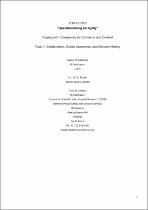JavaScript is disabled for your browser. Some features of this site may not work without it.
- ResearchSpace
- →
- Research Publications/Outputs
- →
- Conference Publications
- →
- View Item
| dc.contributor.author |
Oosthuizen, Rudolph

|
|
| dc.contributor.author |
Roodt, JHS

|
|
| dc.date.accessioned | 2012-11-29T12:49:39Z | |
| dc.date.available | 2012-11-29T12:49:39Z | |
| dc.date.issued | 2012-06 | |
| dc.identifier.citation | Oosthuizen, R and Roodt, JHS. "Operationalizing C2 agility”. Coping with complexity in command and control. 17th International Command and Control Research and Technology Symposium, Fairfax, Virginia, USA, 19-20 June 2012 | en_US |
| dc.identifier.uri | http://www.dodccrp.org/events/17th_iccrts_2012/post_conference/papers/072.pdf | |
| dc.identifier.uri | http://hdl.handle.net/10204/6385 | |
| dc.description | 17th International Command and Control Research and Technology Symposium, Fairfax, Virginia, USA, 19-20 June 2012 | en_US |
| dc.description.abstract | Combat presents a complex system that requires effective management to ensure successful completion of missions. Management of own forces and other assets in the pursuit of mission objectives is performed by the Command and Control (C2) system. The trend of modern combat is to move away from conventional warfare, increasing the occurrence of “messy” and “wicked” problems. Modern C2 systems require new frameworks and designs to cope with the increase in complexity experienced in warfare. Despite the trend to automate analysis and decision making, humans are still better equipped for providing creative solutions to unforeseen occurrences. Development of C2 systems must focus on assisting the human to enhance his cognitive capabilities and experience. Complexity should not be avoided, rather embraced for its richness in reaching creative solutions. Possible approaches are advances in the field of Cognitive Work Analysis (CWA) for designing displays and Human Machine Interfaces (HMI) and utilising Snowden’s Cynefin framework. The objective of these two approaches is to make sense of the available information to support effective decision making in a complex environment. The aim of this paper is to describe an approach, focussed on the complexity aspects, to developing C2 systems. | en_US |
| dc.language.iso | en | en_US |
| dc.relation.ispartofseries | Workflow;9568 | |
| dc.subject | Command and control | en_US |
| dc.subject | Human Machine Interfaces | en_US |
| dc.subject | HMI | en_US |
| dc.subject | Cognitive Work Analysis | en_US |
| dc.subject | CWA | en_US |
| dc.title | "Operationalizing C2 agility”. Coping with complexity in command and control | en_US |
| dc.type | Conference Presentation | en_US |
| dc.identifier.apacitation | Oosthuizen, R., & Roodt, J. (2012). "Operationalizing C2 agility”. Coping with complexity in command and control. http://hdl.handle.net/10204/6385 | en_ZA |
| dc.identifier.chicagocitation | Oosthuizen, Rudolph, and JHS Roodt. ""Operationalizing C2 agility”. Coping with complexity in command and control." (2012): http://hdl.handle.net/10204/6385 | en_ZA |
| dc.identifier.vancouvercitation | Oosthuizen R, Roodt J, "Operationalizing C2 agility”. Coping with complexity in command and control; 2012. http://hdl.handle.net/10204/6385 . | en_ZA |
| dc.identifier.ris | TY - Conference Presentation AU - Oosthuizen, Rudolph AU - Roodt, JHS AB - Combat presents a complex system that requires effective management to ensure successful completion of missions. Management of own forces and other assets in the pursuit of mission objectives is performed by the Command and Control (C2) system. The trend of modern combat is to move away from conventional warfare, increasing the occurrence of “messy” and “wicked” problems. Modern C2 systems require new frameworks and designs to cope with the increase in complexity experienced in warfare. Despite the trend to automate analysis and decision making, humans are still better equipped for providing creative solutions to unforeseen occurrences. Development of C2 systems must focus on assisting the human to enhance his cognitive capabilities and experience. Complexity should not be avoided, rather embraced for its richness in reaching creative solutions. Possible approaches are advances in the field of Cognitive Work Analysis (CWA) for designing displays and Human Machine Interfaces (HMI) and utilising Snowden’s Cynefin framework. The objective of these two approaches is to make sense of the available information to support effective decision making in a complex environment. The aim of this paper is to describe an approach, focussed on the complexity aspects, to developing C2 systems. DA - 2012-06 DB - ResearchSpace DP - CSIR KW - Command and control KW - Human Machine Interfaces KW - HMI KW - Cognitive Work Analysis KW - CWA LK - https://researchspace.csir.co.za PY - 2012 T1 - "Operationalizing C2 agility”. Coping with complexity in command and control TI - "Operationalizing C2 agility”. Coping with complexity in command and control UR - http://hdl.handle.net/10204/6385 ER - | en_ZA |






